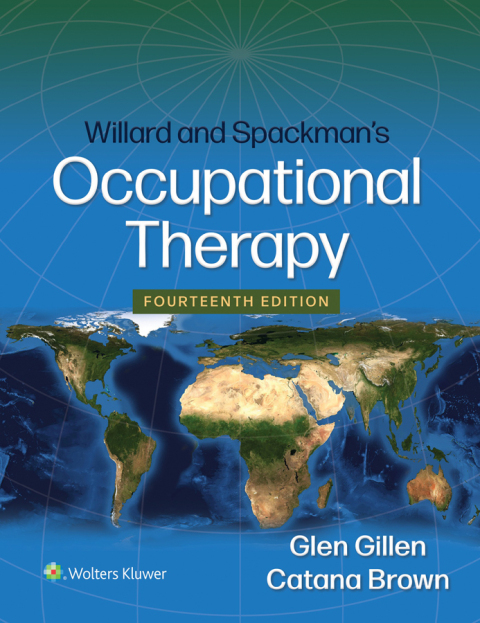Description
Efnisyfirlit
- Cover
- Halftitle Page
- Title Page
- Copyright Page
- Dedication
- On the Cover
- Contributors
- Advisory Group
- Preface
- Acknowledgments
- Brief Contents
- Contents
- Features
- Online Video Clips
- UNIT I Occupational Therapy: Profile of the Profession
- 1 What Is Occupation?
- 2 A Contextual History of Occupational Therapy
- 3 A Philosophy of Occupational Therapy
- 4 Contemporary Occupational Therapy Practice and Future Directions
- 5 Occupational Therapy Professional Organizations
- 6 Scholarship in Occupational Therapy
- UNIT II Occupational Nature of Humans
- 7 Emergence, Development, and Transformation of Occupations
- 8 Contribution of Occupation to Health and Well-Being
- 9 Occupational Science: The Study of Occupation
- 10 Occupational Justice
- 11 Occupational Consciousness
- UNIT III Occupations in Context
- 12 An Occupational Therapy Perspective on Families, Occupation, Health, and Disability
- 13 Patterns of Occupation
- 14 Culture, Equality, Inclusion, Diversity, and Culturally Effective Care
- 15 Social, Economic, and Political Factors That Influence Occupational Performance
- 16 Disability Rights in Action
- 17 Physical and Virtual Environments: Meaning of Place and Space
- UNIT IV Occupational Therapy Process
- 18 Overview of the Occupational Therapy Process and Outcomes
- 19 Evaluating Clients
- 20 Critiquing Assessments
- 21 Occupational Therapy Interventions for Individuals
- 22 Occupational Therapy Evaluation and Intervention for Communities and Populations
- 23 Best Practices for Health Education
- 24 Modifying Performance Contexts
- UNIT V Core Concepts and Skills
- 25 Professional Reasoning in Practice
- 26 Evidence-Based Practice: Integrating Evidence to Inform Practice
- 27 Ethical Practice
- 28 Therapeutic Relationships and Person-Centered Collaboration: Applying the Intentional Relationship Model
- 29 Group Process and Group Intervention
- 30 Professionalism, Communication, and Teamwork
- 31 Documentation in Practice
- 32 Safety, Infection Control, and Personal Protective Equipment
- UNIT VI Broad Conceptual Models for Occupational Therapy Practice
- 33 Examining How Theory Guides Practice: Theory and Practice in Occupational Therapy
- 34 The Model of Human Occupation
- 35 Ecologic Models in Occupational Therapy
- 36 Theory of Occupational Adaptation
- 37 The Kawa (River) Model
- 38 The Model of Occupational Wholeness: An Emerging Theory in Occupational Therapy
- 39 Recovery Model
- 40 Health Promotion Theories
- 41 Principles of Learning and Behavior Change
- UNIT VII Evaluation, Intervention, and Outcomes for Occupations
- 42 Introduction to Evaluation, Intervention, and Outcomes for Occupations
- 43 Analyzing Occupations and Activities
- 44 Activities of Daily Living and Instrumental Activities of Daily Living
- 45 Education in the United States
- 46 Work
- 47 Play and Leisure
- 48 Sleep and Rest
- 49 Social Participation
- 50 The Role of Occupational Therapy in Health Management: The Time to Act Is Now!
- 51 Routines and Habits
- UNIT VIII Evaluation, Interventions, and Outcomes for Performance Skills and Client Factors
- 52 Evaluating Quality of Occupational Performance: Performance Skills
- 53 Individual Variance: Body Structures and Functions
- 54 Motor Function and Occupational Performance
- 55 Cognition, Perception, and Occupational Performance
- 56 Sensory Processing in Everyday Life
- 57 Emotion Regulation
- 58 Social Interaction and Occupational Performance
- 59 Personal Values, Beliefs, and Spirituality
- UNIT IX The Practice Context: Therapists in Action
- 60 Practice Settings for Occupational Therapy
- 61 Providing Occupational Therapy for Autistic Individuals
- 62 Providing Occupational Therapy for Individuals With Traumatic Brain Injury: Intensive Care to Community Reentry
- 63 Providing Wellness-Oriented Occupational Therapy Services for Persons With Mental Health Challenges
- 64 Providing Occupational Therapy for an Individual With a Hand Injury
- 65 Providing Occupational Therapy for Older Adults With Changing Needs
- 66 Forced Migration and the Role of Occupational Therapy
- 67 Providing Occupational Therapy Services Through Telehealth
- 68 Occupational Therapy Practice Through the Lens of Primary Health Care
- 69 Providing Occupational Therapy Services for Persons With Childhood Trauma
- UNIT X Occupational Therapy Education
- 70 Fieldwork, Practice Education, and Professional Entry
- 71 Competence and Professional Development
- 72 Preparation for Work in an Academic Setting
- UNIT XI Occupational Therapy Management
- 73 Management of Occupational Therapy Services
- 74 Supervision of Occupational Therapy Practice
- 75 Consultation as an Occupational Therapy Practitioner
- 76 Payment for Healthcare Services
- Introduction to Appendixes
- APPENDIX I Table of Interventions: Listed Alphabetically by Title
- APPENDIX II Table of Assessments: Listed Alphabetically by Title
- APPENDIX III First-Person Narratives
- A: Narrative as a Key to Understanding, Ellen S. Cohn and Elizabeth Blesedell Crepeau
- B: Who’s Driving the Bus? Laura S. Horowitz, Will S. Horowitz, and Craig W. Horowitz
- C: Homelessness and Resilience: Paul Cabell’s Story, Paul Carrington Cabell III, Sharon A. Gutman, and Emily Raphael-Greenfield
- D: While Focusing on Recovery, I Forgot to Get a Life, Gloria F. Dickerson (updated for the 14th edition)
- E: Mom’s Come to Stay, Jean Wilkins Westmacott
- F: Journey to Ladakh, Beth Long
- G: Experiences With Disability: Stories From Ecuador, Kate Barret
- H: An Excerpt From The Book of Sorrows, Book of Dreams, Mary Feldhaus-Weber and Sally A. Schreiber-Cohn
- I: He’s Not Broken—He’s Alex, Alexander McIntosh, Laurie McIntosh, and Lou McIntosh
- J: The Privilege of Giving Care, Donald M. Murray
- Glossary
- Index






Reviews
There are no reviews yet.